Schweitzer to Canada
From the Winter 2021 Issue
Going the distance on the Selkirk Crest... times two
Scroll down for bonus video, The Hermit: When Cats Go Missing
by Cate Huisman
Drone photos by Gwen Le Tutor. Gibson group photos courtesy the expedition.
Local E.J. Jensen has skied the Schweitzer backcountry for years. He’s done the Redneck Traverse over to Caribou Creek and out the Pack River more times than he can count. He’s skied out of the West Fork Cabin up near the Canadian border a few times, and he’s snowmobiled by Roman Nose and onto the Selkirk Crest from Priest Lake.
But until last winter, he’d never linked all his routes together. To look for a route that would take him from Schweitzer to Canada, E.J. started out at home: “I bought all the topos and put them all together on the kitchen floor.” The idea was to stay on the Selkirk Crest where possible, but ultimately he chose a route that was a compromise between appealing ski descents and “actually being able to make it there.” The last piece fell into place when he found a logging road that went right to the border.
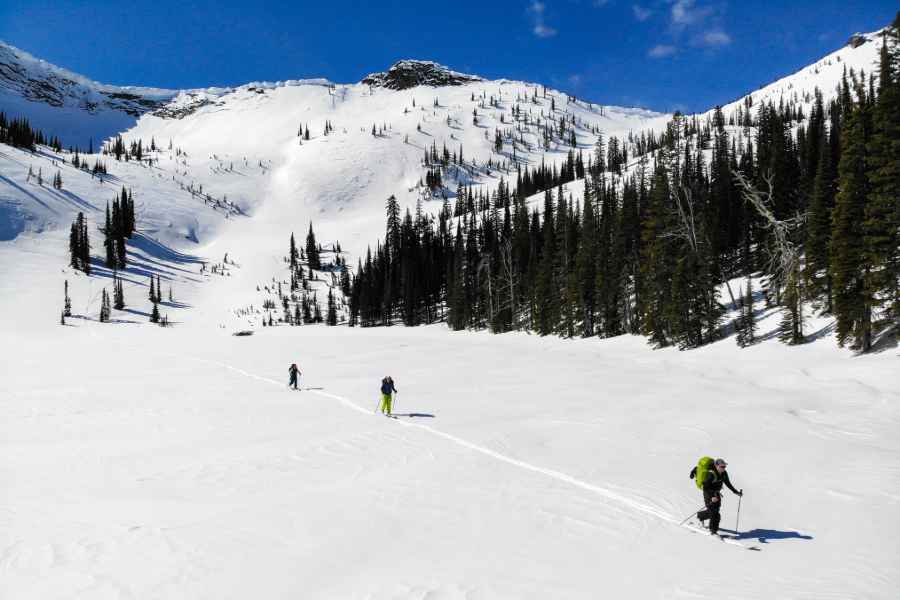
SKINNING ACROSS HARRISON LAKE ON DAY FOUR.
He recruited two skiing buddies, local firefighters Britian Whitley and Cody Lile, to attempt the route. They agreed that the latter half of March would be the best time window, when days are growing longer but there is still plenty of snow. Before then, they set up caches two days’ skiing apart, which enabled them to keep their pack weights down to 30 pounds, a reasonable amount for skiing. They tried out their tent, set up the route on a navigation app, and uploaded it to their phones. But despite all the planning, they didn’t know whether they would be able to complete the traverse. None of them had done anything like it before.
“March 15 was a really nice day,” Jensen recalled, so they decided to go for it then. A ridge of high pressure had built behind a major storm, and they ended up having clear weather for the whole trip. Being able to see their route was crucial, making navigation much easier than it would have been in the fog and clouds that locals know often beset the Selkirk Crest.
“Day 1 was basically the Redneck Traverse plus a little; we’d done that dozens of times,” said Jensen. Heading north from Schweitzer’s Sky House, they found that the aftereffects of the storm (which Sandpoint residents will remember from the number of trees it left in the streets) were a mixed blessing. The firm crust it created made for good traveling conditions where their skis didn’t sink into deep soft snow. But it also made the downhill runs less fun.
Arrival at their first camp led to a flurry of activity. First, they tried to get anything that was wet into the sun to dry, although there was little sunlight left. They put their stove’s fuel canisters inside their clothing to warm them up. While Lyle and Whitley set up their tent, Jensen started melting snow for water, trading in a warmed fuel canister from someone’s clothing each time the stove fuel started to cool.
“As soon as the sun went down, it was 20 degrees colder instantly,” said Jensen. They put on all their clothing, whether it had dried or not. At night they slept with their damp boot liners in their sleeping bags to keep them from freezing.
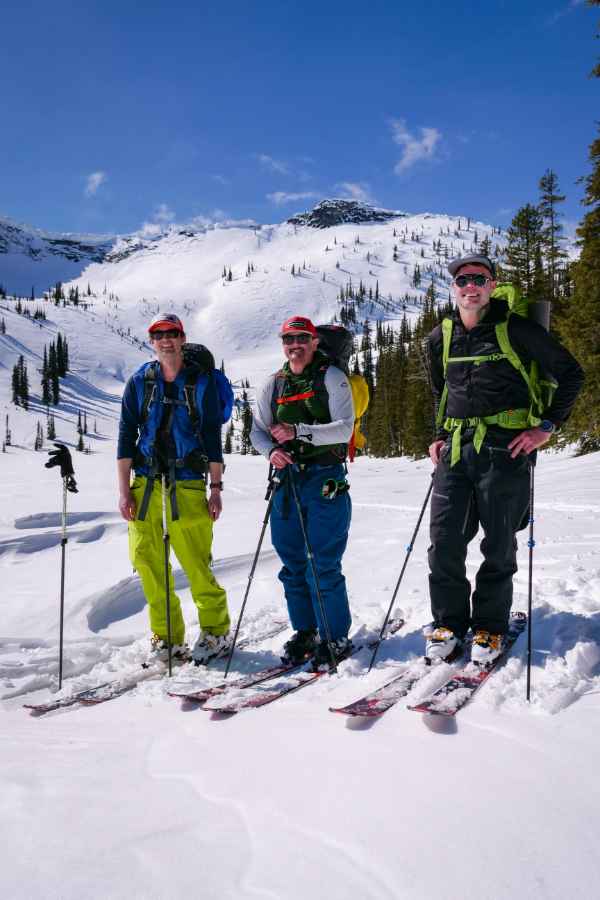
RIGHT, E.J. JENSEN, CODY LILE, AND BRITIAN WHITLEY, READY FOR ADVENTURE.
On the second morning, the team struck out into terrain they weren’t as familiar with. From the north side of Flat Top Mountain, they dropped down into a low drainage, and from there it was all uphill. “There was one little spot in the middle where we skied [downhill] a little bit,” said Jensen. For the rest, “It was eight hours straight with skins on.” Skins are strips of napped material attached to the bases of skis that enable skiers to travel uphill without sliding backward—they are essential equipment for this kind of expedition.
The team had been looking forward to removing the skins for a final descent to Fault Lake, but the fun failed to materialize.
“On paper it should have been one of the best skis,” said Jensen. Instead, it was “a quick ski, but not an enjoyable one. The snow was rock hard.”
Worse yet, they didn’t make it to their cache. It had been hard to make good time in the thick timber down low, and all the hours on skins the rest of the day still weren’t enough.
Despite an awesome sunset, this evening was the low point of the trip. “You’re finally starting to realize what you got yourself into,” said Jensen. Resigned to making do with what they had with them, they repeated the pattern of setting up the tent, drying clothes, and melting water. “The hardest thing to do was to have stoves going long enough to make enough water for three guys, plus water for the next day,” Jensen said. There was no running water anywhere on the route, and they ran the stoves for three to four hours a night just to have enough water for cooking and drinking.
For the first two days, aborting the trip would have been relatively easy; they could head down to the Pack River Road if they felt they had bitten off more than they could ski. But as they moved north on Day 3, bailing out became progressively harder. Fortunately, they also grew more confident as the rhythm of their travel became established. As Jensen said, “You didn’t really have to be fast; you just have to keep going. Once you got used to that, it was okay.” Mornings they were on their skis by 8:30 or 9 a.m., and they kept skiing until 5:30 or 6 p.m.
Beyond just completing the miles, the trio had to keep themselves safe. Because of the cold, the remoteness, the objective hazards of skiing injuries and avalanche danger, they had to take more precautions than on their day trips closer to civilization.
“Avalanche conditions were really stable,” Jensen remembered.
“It was easy to travel quickly.” Nevertheless, they had to stop occasionally to dig pits to assess the stability of the snow, and to forego some lines they would have enjoyed skiing.
Except for missing their cache on Day 2, the skiers made the mileages they had planned. Although they were out of cell phone contact most of the time, they found a spot where their phones worked on Day 4, so they were able to call and confirm their plans with the friends who were to meet them at the end of the trip.
By the evening of Day 5, the group had reached the West Fork Cabin on Smith Creek northwest of Bonners Ferry, where they spent the night. The next day, they left their packs at the cabin and skied a couple of descents to the road Jensen had found on the map, which fulfilled its promise as the last piece to fall into place. They reached the border about 4 p.m., and then sat down in the snow to drink a beer, feeling both elated at their accomplishment and sad that it was over.
Then their friends met them on snowmobiles and towed them back to the cabin, where they attempted to celebrate. “But we were all so trashed and tired, it wasn’t too much of a party,” Jensen recalled.
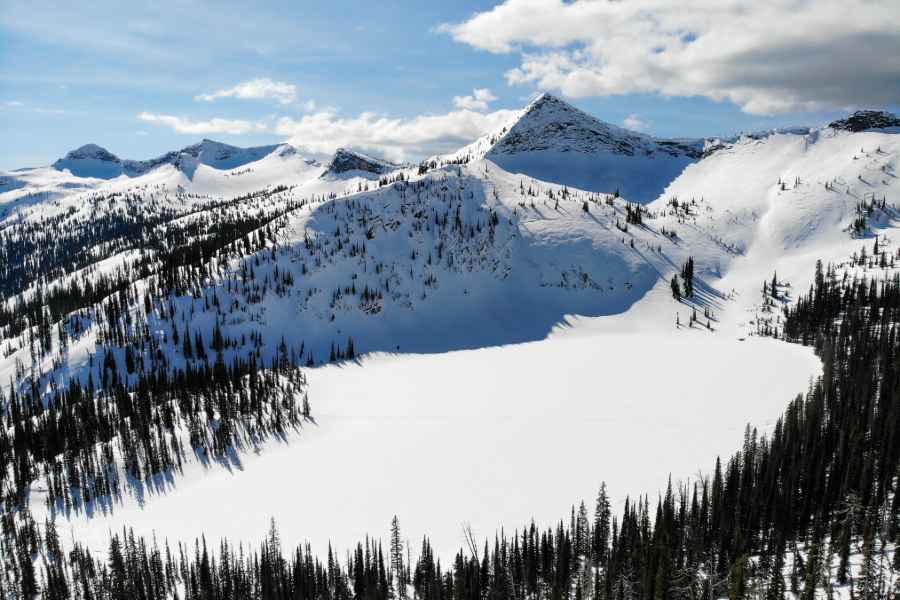
HARRISON LAKE LOOKING SOUTH ALONG THE SELKIRK CREST AND THE SEVEN SISTERS.
He figures they skied 63 miles and climbed a combined total of about 21,500 vertical feet. As far as they know, they are the first party to have completed this traverse in winter. And other than that missed cache, a broken boot buckle, and a few minor blisters, it went off without a hitch, leaving them eager to head out again. This winter, they’re thinking of setting up a base camp so they can ski some of the lines they had to pass by on their destination-driven traverse. Or maybe they’ll try a traverse through the Cabinets. They have some other friends who might want to come along. They’ll be looking for another weather window, maybe with better snow for descents.
The first traverse was clearly just the beginning. A second band, the Gibson Group, was about to embark on their own adventure.
But first, here’s a bonus video the Gibson group captured en route, complete with a fanciful tale … albeit there really was a Hermit Schweitzer who did, in fact, eat cats.
Traverse Redux: Gibson’s Group
After Jensen and friends returned from their trip to the Canadian border (previous story), winter came back to the Selkirks, and in its midst, a second group of snow travelers headed out along the crest.
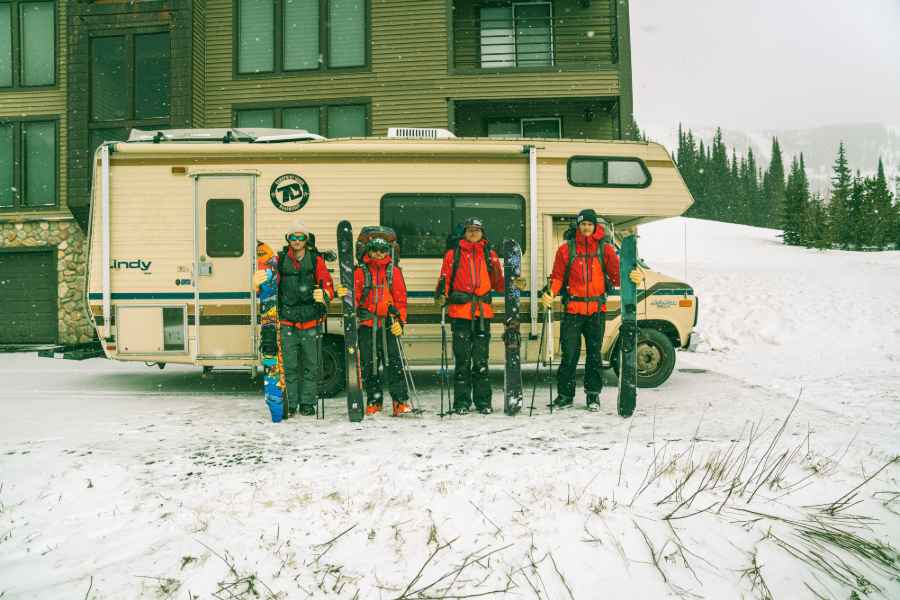
THE SELKIRK TRAVERSE CREW, KIX KAMP, JASPER GIBSON, JOEY SACKETT, AND ZEPPELIN ZEERIP. KIX WOULD END UP BAILING OUT AFTER THE FIRST DAY DUE TO FAMILIAL FACTORS.
The son of a Schweitzer patroller, Jasper Gibson used to hang out in the lift shack at the top of the old Snow Ghost lift and gaze over the sea of mountains beyond it. The trip he planned at the end of March with friends Zeppelin Zeerip and Joey Sackett was a chance to immerse themselves in that landscape for 10 days. While they were thinking of tapping the Canadian border, they just wanted to ski and ride—Gibson was on skis, while Zeerip and Sackett were on splitboards—snowboards that split in half so riders can attach skins and climb uphill.
For five days after they set out from the top of Schweitzer’s T-bar, it dumped snow. After being inundated with the white stuff their first night—Gibson remembers 1 to 2 inches an hour
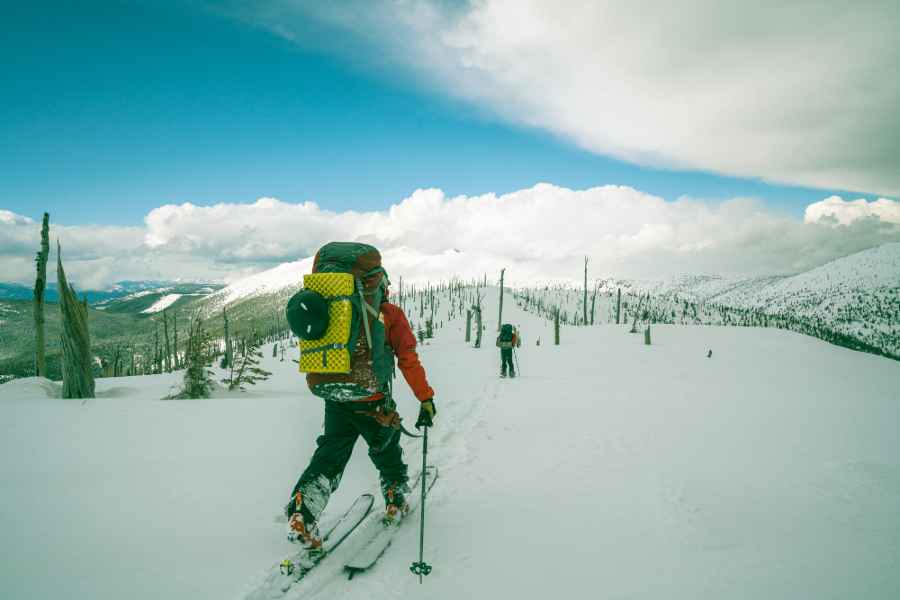
JASPER AND JOEY SKINNING THEIR WAY THROUGH AN OLD BURN ON THE SECOND DAY. THAT DAY THE TRIO TRAVERSED 10 MILES OVER PEAKS AND INTO DRAINAGES.
—they traversed north to Jeru Peak and their first cache. There they paused to spend an entire day exploring. The following day took them past Fault Lake and to a fabulous ski down McCormick Ridge that Gibson said was “one of the best tree skiing runs of my life”—no small claim from a person who has been skiing since he was two. With a beautiful camp in a bowl they called “Old Man’s Hollow,” for its big trees draped with goat’s beard moss, they spent another snowy day sightseeing.
Day 6 was less fun. During a long traverse north, “The snow was clumping to our skins and the top of our skis; we were getting soaked, it was everywhere.” Gibson estimates the sticky snow added 10 pounds to the weight they were each carrying. And the day ended with Zeerip’s snowboard breaking.
So Day 7 required an exit down to the Pack River Road. Zeerip had repaired his board as best he could and descended with its tail flapping behind him. After the exit, his time ran out; other commitments meant he wouldn’t come back to complete the trip.
But Gibson and Sackett headed back in a few days later. The weather had changed again; they had nothing but sun and stars for their last few days on the crest. After a beautiful sunset ski north of Harrison Peak the first night, and a camp at Long Canyon Pass the next, they headed across Smith Peak and out Smith Creek for their final night out.
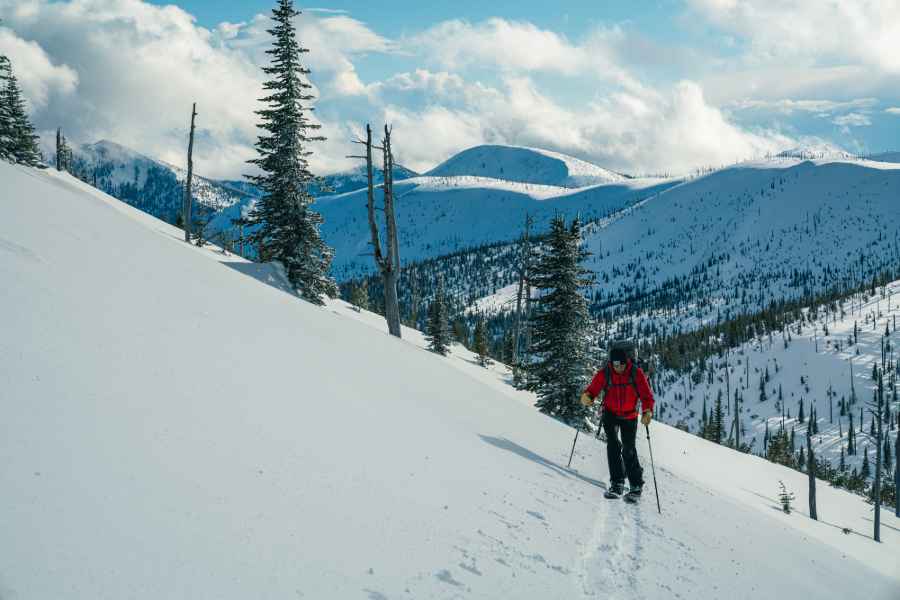
ZEPPELIN MAKING HIS WAY AROUND FLAT TOP MOUNTAIN. THE TERRAIN IN THE DISTANCE IS PART OF WHAT HAD BEEN TRAVERSED THAT DAY.
The sunny spring weather didn’t pay off for their final descent. As Jensen and his party had observed (and legions of other skiers have discovered), fair weather doesn’t always make for great skiing. “The ski down from the Smith Peak area was horrendous,”
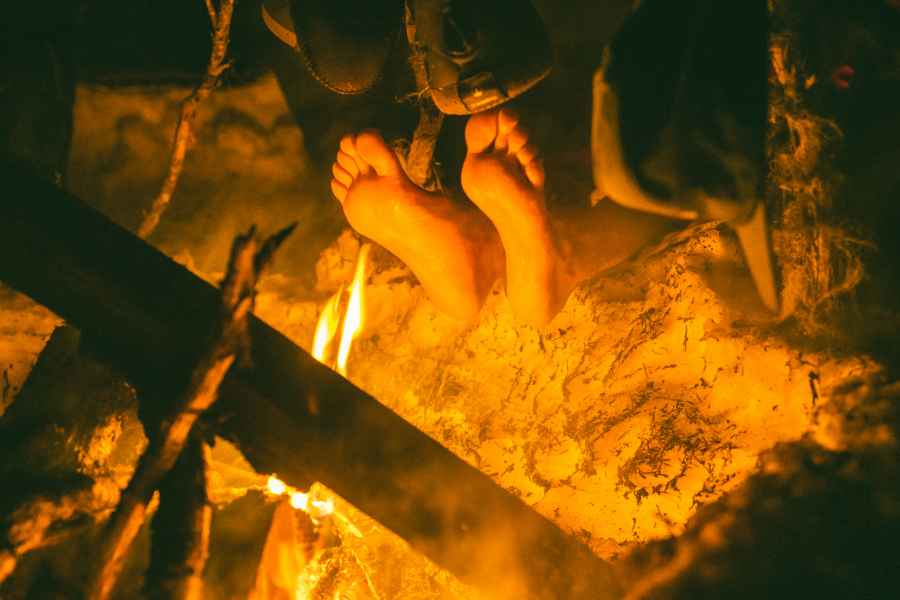
MAYBE THE BEST FEELING EVER.
Gibson recalled. “There was a foot of corn snow sluffing off, and it was insanely heavy.”
The road they finally reached in the basin provided fresh concerns: First they saw cougar tracks, then bear tracks, then cougar scat, then bear droppings. So they spent a fitful evening banging pots and pans, and ultimately survived the night. Friends on snowmobiles brought them out to the roadhead the next morning.
Driving back to Sandpoint, they watched the crest go by above U.S. 95. “I’ve seen those mountains my entire life,” said Gibson. “It was cool to have a new perspective on the range, a new sense of place.”
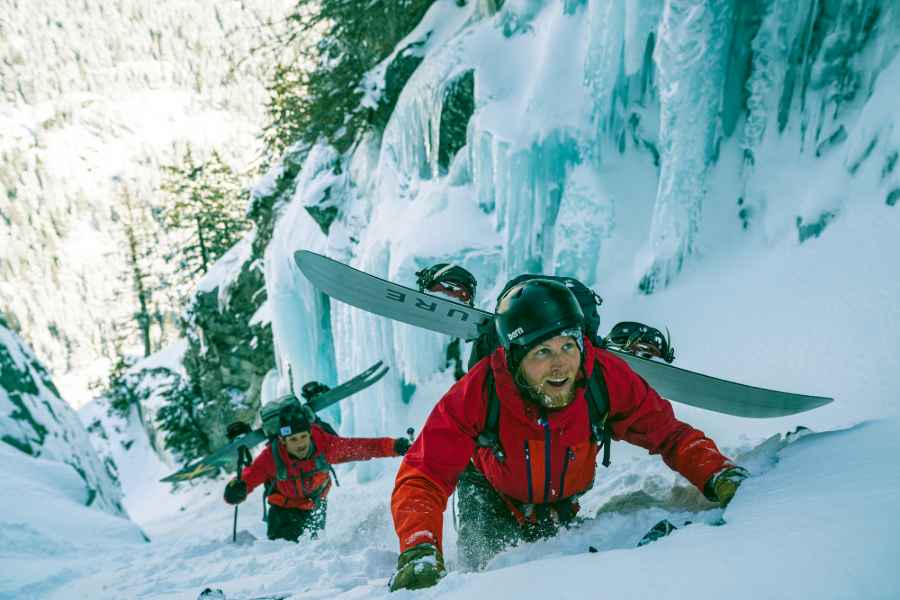
JOEY SACKETT AND ZEPPELIN ZEERIP WALLOW THROUGH WAIST DEEP SNOW EXPLORING AN UNKNOWN COULOIR. THEY NAMED THE COULOIR HEATHER’S HALLWAY AFTER JASPER’S LATE MOTHER.
Gibson lives in Salt Lake City now, but he’s eager to come back to his home state for another traverse. One gets the sense that there will be a lot more ski and snowboard tracks joining those of the bear and cougar in the years to come.




Leave a Reply